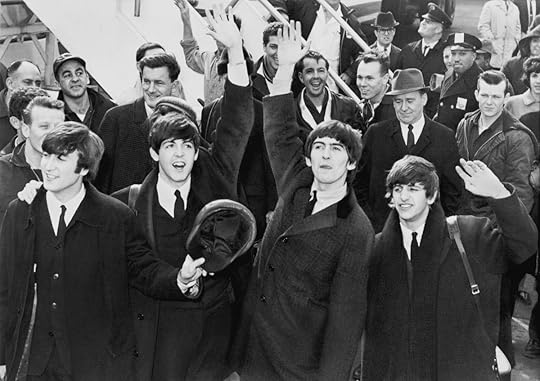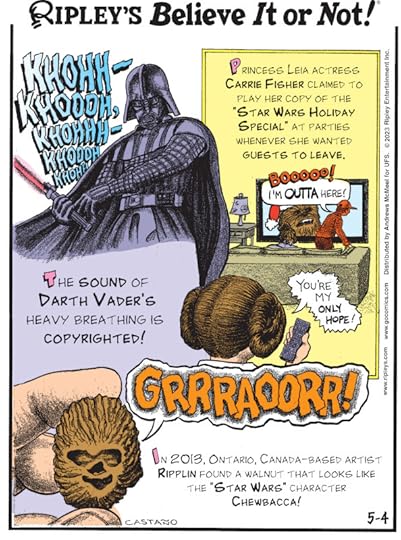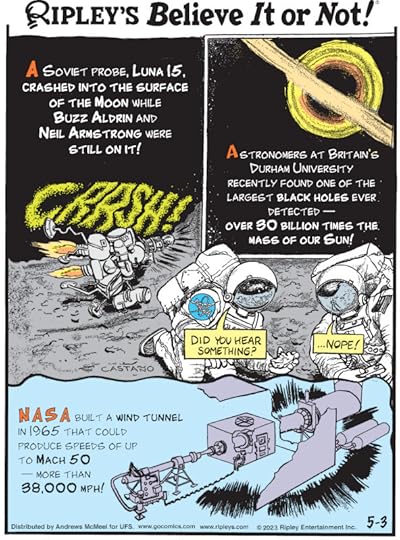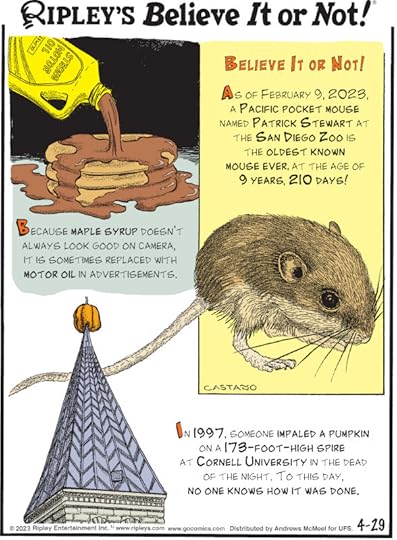Ripley Entertainment Inc.'s Blog, page 29
May 4, 2023
Ripley’s Adds Another Historic Olympic Torch To The Collection
Featured in Ripley's Believe It or Not!

Ripley’s Believe It or Not! recently purchased a torch from the 1968 Winter Games in Grenoble, France, at auction for $200,000! With this purchase, just two torches remain between Ripley’s and a complete collection.
Here’s everything you need to know about the newest addition and the incredible collection it will join.
Rekindling an Ancient FireMore than 1,500 years after Roman Emperor Theodosius I banned the ancient Olympics in Greece, the Olympic Games were reprised on April 6, 1896. Fittingly, the competition re-commenced in Athens, presided over by Greece’s King Georgios I. A crowd of 60,000 people attended, and athletes from 13 nations participated.
By 1924, the second set of games dedicated to winter sports began in Chamonix, France. Initially called the “International Winter Sports Week,” the event quickly morphed into the cold-weather counterpart to the Summer Olympic Games. Over the years, as the addition of the Winter Games attests, the Olympics exploded in popularity and size. And the 2024 Olympic Games slated for Paris will attract more than 10,000 participants from 206 National Olympic Committees (NOCs). (Technically, athletes are picked by NOCs, not nations, to participate in the Games.)
No matter the size of the competition or distance from the ancient past, the flame remains central to the celebration of athletic achievement. Today, the Games’ organizers still light the torch as the ancients did, relying on a parabolic mirror (known as a skaphia) to direct the sun’s rays inward, creating intense, combustible heat. This torch-lighting ceremony is presided over by priestesses dressed in the white gauzy robes of Classical Greece.

Lighting the torch. Editorial credit: Ververidis Vasilis / Shutterstock.com
An Ancient Invention Meets Modern TechnologyWhile the torches used during the ancient Olympic Games saw few (if any) innovations, their modern counterparts must meet a few requirements. The need for cutting-edge innovation is driven by the challenges the flames face during their worldwide relay race from Olympia, Greece, to the final Olympiad destination. The first relay was held during the 1936 Summer Olympics in Berlin, and the Greek runner Konstantin Kondylis made history as the first runner, departing Olympia with the torch in hand.
Because of the nature of the relay, torches must withstand extreme weather, including intense heat, snow, rain, and high winds. Torches must also be able to burn well past the forecasted length of a given leg of the journey to account for runner mishaps and delays. But there is more to Olympic torches than practical considerations.
They must also harmonize with the visual themes (and destination) of each year’s Games, making them highly collectible. To achieve the right look, world-famous designers or firms often craft them. Today, Olympic torches are manufactured on a large scale, often permitting runners in the relay to keep the one they carried as memorabilia. Such was not always the case, which makes assembling a complete collection daunting.
As it currently stands, only two private collectors on the planet own every single torch model. But Ripley’s is on a mission to bring these torches to the public.
A Closer Look at the Grenoble TorchDesigned by Roger Excoffon, the 1968 torch is decorated by three unique silver logo plaques on its sides.

An up close look at one of the three silver logo plaques.
The Grenoble flame was lit in Olympia, Greece, on December 16, 1967 with the initial torchbearer being Tassos Bahouros. The relay went first to Mount Olympus and then onward to Athens. From Athens, the torch was flown to Paris with Alain Mimoun (3-time silver winner in London 1948, 2-time silver winner in Helsinki 1952, and marathon gold winner in Melbourne 1956) being the first torchbearer, and Alan Calmat (figure skating silver in Innsbruck 1964) being the last torchbearer at the Opening Ceremony on February 6, 1968.
Believe It or Not!, 5,000 torchbearers carried the flame through France, sharing the small number of torches made for the relay.
Two More to GoCollecting Olympic torches comes with a hefty price. Individual pieces can cost tens of thousands of dollars. But as one collector of torches, Lucky Burke, argues, they outperform other sports memorabilia by a long shot: “They transcend age and politics. Young people don’t always know who older baseball players are, but they all know about the Olympics.”

Where can you see Ripley’s expansive collection today? According to John Corcoran, Ripley’s director of traveling shows and Guinness World Records attraction development, “Many of our torches are currently on display around the world. As those attractions are renovated, we are slowly returning the torches to our Archives. Our goal is to develop a display that features all of the torches together.”
To complete the collection, Ripley’s has its sights set on two more torches from the Games in Helsinki, Finland, and Innsbruck, Austria. Why the trouble getting these last two models? The Helsinki Games only have 22 torch models left, with very few in private hands. As for Innsbruck, there are only one or two original torches and very few authorized replicas.
By Engrid Barnett, contributor for Ripleys.com
EXPLORE THE ODD IN PERSON! Discover hundreds of strange and unusual artifacts and get hands-on with unbelievable interactives when you visit a Ripley’s Odditorium!Source: Ripley’s Adds Another Historic Olympic Torch To The Collection
CARTOON 05-04-2023
May 3, 2023
The Beatles, The British Invasion, And 1,000 Pounds Of Wigs
Featured in Ripley's Believe It or Not!

In early 1963, the Beatles released their second single, “Please Please Me,” in the United Kingdom to rave reviews. It was their first single released stateside. Some might argue this paved the way for the so-called “British Invasion.” After all, by early 1964, Life magazine had this to say about the Beatles: “In [1776] England lost her American colonies. Last week, the Beatles took them back.”
But it’s easy to forget the real story of the Beatles’ first US single release in the glare of the band’s later successes. In reality, “Please Please Me” was a resounding flop. Here’s the inside scoop on how the bowl-cut band went from unknowns with a less-than-stellar single to America’s hottest ticket (and merch seller).
An Unlikely Birthplace for Rock & Roll’s SaviorsFebruary 25, 1963, should be a date to remember. At least when it comes to the history of the Beatles. After all, that’s when the first single by the band hit America’s airwaves. In the larger context of “Beatlemania,” it should’ve been a slam dunk, foreshadowing the uber-famous “British Invasion” to follow. But that’s also an anachronistic way of looking at history.
Despite what Elvis Presley and Buddy Holly started in the 1950s, rock & roll appeared in a death spiral by the early 1960s as folk dominated the scene. England was the last place on Earth people looked for potential saviors. After all, London’s Denmark Street music publishers and the BBC maintained a stranglehold on the British music industry. And they fastidiously obsessed over clean-cut Elvis and Buddy wannabes. Hardly the environment for innovation.
Liverpool’s Vibrant Music SceneHowever, that doesn’t mean the Beatles came out of a cultural vacuum. Their location in the coastal city of Liverpool proved fortuitous. You see, Liverpool had a fascinating and unique scene of performers. In fact, it’s a testament to these other performers’ talent that the Beatles took so long to gain a foothold.

Penny Lane road, Liverpool, United Kingdom.
Local bands like Rory Storm and the Hurricanes and the Big Three dominated with a unique blend of beat music and R&B known as skiffle. (Incidentally, Rory Storm and the Hurricanes featured a drummer named Richard Starkey, who soon reinvented himself as Ringo Starr.) Skiffle, in turn, was inspired by Liverpool’s merchant seamen who imported R&B records from the United States.
From Skiffle to World FameAnother misnomer about the Beatles is that they represented an overnight success. But this was far from the case. In truth, they paid their dues, commuting between Liverpool and Hamburg from 1961 through 1963, performing clad in black leather at dives like the Star Club, the Cavern, and the Kaiserkeller. Skiffle proved among their primary influences.
Along the way, the band’s lineup changed substantially, and they picked up manager Brian Epstein, a local record-store manager. Ringo Starr came on board, providing a new solidity to the group as they bid “hasta la vista” to the black leather. (No offense, Judas Priest!) Having played nearly 300 performances by August 1963, the band boasted two well-received singles: “Please Please Me” and “From Me to You.” That is, well-received in their homeland.
The British Invasion BeginsBut America would prove a tougher sell. Even as their third and fourth singles inspired the Daily Mail to proclaim the band’s rising popularity as “Beatlemania,” fans in the US remained sparse to non-existent. However, something funny took place in December 1963. That’s when the Beatles’ single “I Want to Hold Your Hand” made the Washington, DC, radio station WWDC. Audiences were entranced!

Vintage Beatles Merchandise. Credit: Lauren Gerson Via Wikimedia Commons.
The band followed this more favorable debut with a strategic campaign in preparation for their first American tour. Set to begin in February 1964, the Beatles went all out. Think campaign-style buttons, bumper stickers, and even “Beatle wigs.” By February 19, more than 1,000 pounds of these Beatle wigs traveled to the United States to satisfy the new mania for rock-related merch. Sure, it was a far cry from Hot Topics but still a significant step in music branding. By 1964, things got really weird with the Fab Four’s board game, “Flip Your Wig.”
Marketing a Cultural RevolutionIt’s hard to imagine the cultural revolution of the 1960s taking place without the Beatles. Yet, it’s also disheartening to acknowledge much of the hubbub surrounding the band can be chalked up to clever marketing rather than a looming “Age of Aquarius.” Nevertheless, the Beatles’ jaw-dropping performance on The Ed Sullivan Show on February 9, 1964 cemented their fame. More than 70 million tuned it, making it the boob tube’s most successful broadcast up to that point.
As the “British Invasion” swept the United States, the Beatles reigned over the parade, contributing countless chart toppers. By April, their hits dominated the Top 100. They included “Can’t Buy Me Love,” “Twist and Shout,” “She Loves Me,” and the song that paved the way for fame, “I Want to Hold Your Hand.”
So, what happened to “Please Please Me?” The song finally became a contender, topping America’s charts. While it appeared that the Beatles had become the United Kingdom’s number one export overnight, bringing them to the former colonies required calculated strategy, years of hard work, and plenty of wigs. Nowhere is this slow and steady trajectory better attested than “Please Please Me’s” circuitous rise to popularity in the New World.
By Engrid Barnett, contributor for Ripleys.com
EXPLORE THE ODD IN PERSON! Discover hundreds of strange and unusual artifacts and get hands-on with unbelievable interactives when you visit a Ripley’s Odditorium!Source: The Beatles, The British Invasion, And 1,000 Pounds Of Wigs
CARTOON 05-03-3023
May 2, 2023
Critter Stories You Won’t Believe (That Are 100% True!)
Featured in Ripley's Believe It or Not!

They say that truth is stranger than fiction. And the same goes for nature. After all, the animal kingdom is chock full of bizarre creatures, whether we’re focusing on behaviors, diets, or looks, we can’t blame all the weirdness on animals alone. Sometimes the most fascinating stories involving critters are fueled by human activity.
Keep reading as we closely examine some of the most unique recent news about mammals, birds, reptiles, and insects.
Scientists Taught Parrots to Video Chat… Then, This HappenedIf you’ve ever had the pleasure of seeing parrots in the wild, you know birds of a feather flock together. While many parrots have ended up stateside living single in cages, they haven’t necessarily gotten used to ruling the roost. In fact, you could say our beaked companions are lonely. Fortunately, a new scientific study has brought light to the situation while providing a potential solution. And we have technology to thank for it.
A group of researchers from the University of Glasgow, Northeastern University, and MIT presented their findings at the 2023 Conference on Human Factors. After teaching domesticated parrots how to video call other bird brains, they were amazed by the results. Study subjects came from Parrot Kindergarten, an online training program for pets and their owners. Scientists taught these birds to ring a bell. From there, they touched the image of another parrot, initiating a video call.
All told, 212 video calls resulted from this activity. Next, they let the animals run wild, dialing their friends as often as they wanted. This resulted in nearly 150 deliberate phone calls between birds and 1,000 hours of video footage. Ilyena Hirskyi-Douglas, co-author of the study, explains what happened next. “Some would sing, some would play around and go upside down, others would want to show another bird their toys.” In other words, they communicated individually, exhibiting behaviors similar to human society.
Mojave Max Is Fashionably Late in Sin CityMove over, Punxsutawney Phil! There’s a new weather predictor in town, and his popularity is growing by leaps and bounds. His name is Mojave Max, and he emerges from his winter burrow annually, predicting when spring will begin. The desert tortoise is the stuff of local lore, and he’s also become a favorite of schoolchildren in Las Vegas, Nevada.
He typically leaves his burrow anywhere between February 14th and April 17th, bringing to a close his cold weather slumber, known as brumation. But this year has marked a surprising exception. Arriving fashionably late on April 24th, he brought a girlfriend for the big debut at Springs Preserve. This is the latest he’s shown up since 2000! What took the little, shelled guy so long? According to Tom Bradley, Jr., spokesman of the preserve, “It’s taken longer for the soil in the burrow to warm. Once it finally warmed up, Max came out.”
Mojave Max’s companion has also provided the preserve with a reason to celebrate. After all, desert tortoises have been listed as a threatened species since 1990. As it turns out, life in the desert is hard knock. From wildfires to invasive species, road mortalities to predation, these turtles face countless obstacles throughout their lives, yet they keep chugging along. Despite the lateness of Spring 2023, we hope Mojave Max and his lady friend will soon welcome a new set of shelled babies into the world.
Bold Jumping Spiders Go Blind With Hunger… LiterallySome people turn into divas when hungry, and others curl into a ball and go to sleep. While understandable human behaviors, they can’t compare to the flare and drama that malnourished bold jumping spiders bring to the game. When these fuzzy, eight-legged insects get hungry — we’re talking ravenously hungry — they literally go blind.
Typically, bold jumping spiders have excellent vision. Think high-resolution color vision. But scientists began wondering what was wrong after noticing dark spots on some of the arachnids’ eyes. They soon realized the spots were symptoms of degeneration linked to poor diet.
Elke Buschbeck, a co-author of the study, explains, “The condition of the eyes of the spiders with less nutrition was much worse. We could tell just by looking at them with the ophthalmoscope that some of their photoreceptors had died.” Why does this happen? Because the spider’s photoreceptors need lots of energy to function properly. Without the nutrition that provides this energy, the spiders end up as blind as … well, a bat.
“Beautiful Bulldog” Is a Thing (No, Really!)Every year, Drake University hosts a Beautiful Bulldog competition in search of a face that only furbaby mommies can love. This year’s award winner was recently announced, Patch, a two-year-old English bulldog. She stunned audiences at the event by trotting through a hoop on the runway. All the while, her jowls and wrinkles epitomized the ideal English bulldog.
Of course, bulldogs can’t usually get by on their looks. So, what made officials at Drake decide to host a bulldog beauty pageant in the first place? The school’s mascot, which is (you guessed it!) a bulldog.
What’s up next for the dog celeb? She will now take on the role of mascot in real life (IRL). For a dog that started out as a rescue, it’s tough to beat this rags-to-riches story. Her owner, Jennifer Hinton, could not have predicted where Patch would end up. But she always had faith in her beloved pooch, and it’s that faith that has paid off with the “Beautiful Bulldog” title.
By Engrid Barnett, contributor for Ripleys.com
EXPLORE THE ODD IN PERSON! Discover hundreds of strange and unusual artifacts and get hands-on with unbelievable interactives when you visit a Ripley’s Odditorium!Source: Critter Stories You Won’t Believe (That Are 100% True!)
CARTOON 05-02-2023
May 1, 2023
CARTOON 05-01-2023
April 30, 2023
CARTOON 04-30-2023
April 29, 2023
CARTOON 04-29-2023
April 28, 2023
Up Close & Peculiar With Criminal Minds
Featured in Ripley's Believe It or Not!

Today: Criminal Minds
Today we’re taking a deep dive into the minds of criminals. No, Literally. We’re gonna take a hard look at some skulls and brains. So, let’s go!
Starting with the show stopper: the half head. This once belonged to an 18th century criminal who ended up being publicly hung for his wrongdoings but his public scrutiny did not stop there! After his death, his head was removed and dissected in an attempt to find out if a criminal’s mind medically had noticeable differences. French medical students and doctors studied this brain for over 200 years!
We also have an have an x-ray of Hitler’s skull! Although this x-ray was taken for medical purposes while he was alive and not for research purposes like the French criminal, it’s kind of interesting to literally take a look inside the head of such an abhorrent human being.
There’s a million reasons why people do terrible things and unfortunately sometimes science can’t explain them. But in the meantime it is pretty interesting to take a look inside for yourself and wonder what was going through their heads.
Tell us what you think about these wild artifacts! We hope you enjoyed our criminal mind segment, straight from the Ripley’s Vault!
EXPLORE THE ODD IN PERSON! Discover hundreds of strange and unusual artifacts and get hands-on with unbelievable interactives when you visit a Ripley’s Odditorium!Ripley Entertainment Inc.'s Blog
- Ripley Entertainment Inc.'s profile
- 52 followers









